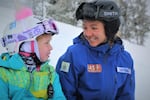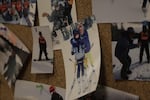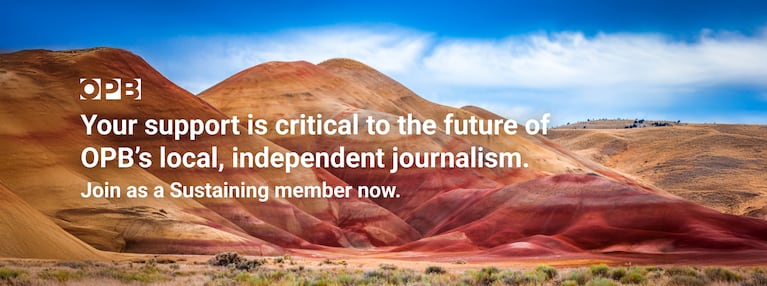When Gabe Rousseau leans to the side, the metal edge of his ski slices into the hard snow, carves a sweeping arc and sprays a snowy plume in his wake. Shifting his hips and extending his arm, he initiates another turn and feels the stomach-grip of centripetal force, the chatter of his ski on ice, and the cold blast of Central Oregon air numb his smiling face. It’s the first run of the day, and finally, Rousseau is no longer fighting gravity.
“My whole life I’m fighting gravity everywhere I go,” he said. “But when I’m up here, that relationship with gravity is inverse.”
When not strapped into his sit-ski and shredding down slopes, Rousseau’s mode of mobility is his wheelchair. “When I get out of bed, when I roll over, whatever I do, it’s a battle. It’s a battle that I can’t articulate accurately or well enough to an able-bodied person. It’s a fight. And it’s there all the time,” he said.
But racing down the slope, he is skier. A good skier.
“Even if you don’t know much about adaptive skiing, you can watch him ski and be like: ‘That guy skis very well!’” said Kellie Standish, of Oregon Adaptive Sports.
Rousseau is one of dozens of folks who regularly come to Mount Bachelor to ski with the support of Oregon Adaptive Sports (OAS).
“Adaptive sports” is a broad term that includes the participation in sports of any kind by individuals of any cognitive and/or physical ability.
A nonprofit based in Bend, OAS does far more than skiing: It helps folks of all ages and abilities to access and recreate in the outdoors – including horseback riding, kayaking and rock climbing. Launched in 1996, the ski program was its first and remains one of its most popular.
From Ski-Crutches To Sliders
After World War II, recreational skiing boomed in popularity. Military veterans who had lost limbs in the war were just as keen as everyone else to hit the slopes. In 1942, Austrian Franz Wendel attached shortened skis to crutches, allowing a one-legged skier to lean forward onto the crutches and “3 track” down the hill. The ski crutches became the prototype for a modern piece of equipment called an “outrigger.”
In Oregon, Lee Perry of the Jaycees ski club, refined the outriggers in a Portland machine shop in 1962. The following year Perry started one of the very first ski schools for amputees in the U.S. on Mount Hood, then wrote the first instruction manual.
This innovative effort to adapt traditional ski gear and to learn new ways to instruct continues today.
Jana Sherry uses a “slider.” It’s essentially a walker on skis. A volunteer skies behind, with two long tethers, but the skier is free to make their own turns.
“She gets to ski in her own space independently,” said Standish, who has been working with Jana for several years. “And I think there’s something really special about even just that spatial separation because she’s skiing on her own and we’re just supporting her.”
“It was amazing to see Jana skiing down the mountain and moving since moving is very difficult for her to have that freedom was very cool,” said Dena Sherry, Jana’s mother. “We had tears in our eyes, that’s for sure.”

Using a "slider" helps Dana Sherry carve her own turns as she and her instructor Kellie Standish ski the half-pipe at Mt Bachelor.
Ian McCluskey / OPB
Jana has a neurological movement disorder known as dystonia. It’s the third most common movement disorder behind Parkinson’s and tremor. “My muscles like to move on their own and I can’t control it,” Jana explained. “Also, my muscles get tight and tense and all of that just makes things a little more difficult.”
Her condition makes it impossible for her to walk on her own and it slows her speech to the point of difficulty that she strains to enunciate each syllable. But at the end of each sentence, her face relaxes and a huge smile beams.
“At OAS everyone is included regardless of what their movements look like, regardless of what their speech is like, regardless of any perceived ability level,” Standish said.
She and Jana have skied together for the past several years, developing a close friendship. As they ski, Jana and Standish make up silly songs, and laugh.
“I’m just a girl who loves to ski but also has some challenges,” Jana said. “But I don’t let those challenges get in the way of my time on the mountain.” Then her face relaxes and breaks once again into her huge smile. She exhales. “Yeah!”
Jana and her slider make slow and sure giant slalom turns as she glides freely downhill.
Not All Disabilities Are Visible
At first glance, Mackenzie Hunniecutt looks like just about any kid on a snowboard. On her helmet she wears a pink and silver unicorn horn. She speeds down the slope, sometimes slipping out of control, falling on her bottom, and giggling.
Her instructor Dayna Vogt, comes in fast behind, and cuts a stop hard enough to spray Mackenzie with snow.
“How dare you!” Mackenzie shrieked, and giggled. “Revenge!” she vowed, and starts to plot when she can lob an unexpected snowball.
To see them interact and banter, you’d never guess that this is an adaptive lesson. Mackenzie’s helmet covers her hearing aids.
“A lot of people look at adaptive programs and what they see is the equipment, but what we serve is so much more than that,” Standish said.
“It’s been really helpful to have one-on-one instruction,” Vogt said. “And I think the biggest piece is just the community and friendship. Like Mackenzie comes into the OAS room and is so confident now and when she first came in she was super shy and now along with being confident on the snow, she walks into the room and has friends and is chatty.”
She turned to Mackenzie and added: “A little sassy.”
Mackenzie hurls a handful of snow at Vogt. “I didn’t see that coming!” Vogt said, wiping the snow from her face.
“I told you I was getting revenge,” Mackenzie said with a giggle.

Mackenzie Hunniecutt (in unicorn helmet) gets one-on-one snowboard lessons from OAS instructor Dayna Vogt
Ian McCluskey / OPB
The Gathering Of Best Days
After their afternoon lesson, Mackenzie and Vogt return to the OAS room to rejoin the other adaptive skiers and instructors.
The room is tucked into the ground floor of the ski lodge of Mt Bachelor Ski Area, almost hidden behind a loading bay.
The small room is packed with laughter, high fives. Everywhere are heaps of jackets, goggles and gloves. A whole wall supports pieces of specialized gear like the sit-skis. There’s a wall covered with ID badges of all the volunteers; at a glance one can see how many folks make this small room the hub of their winter.
“I find myself coming up on my days off,” Standish said. “Because the joy and the pure love for the outdoors and the pure appreciation for it is really, really contagious.”
“Growing up, I didn’t really have a lot of friends that I could be myself around,” Jana said, “and at OAS, I’ve found that.”
On many of the helmets are small stickers that read: “OAS Stoke.” It’s more than a catch-phrase; inside the room it is palatable.

"Best Day Ever" is a popular saying at Oregon Adaptive Sports, and the wall of photos suggest this is indeed true.
Ian McCluskey / OPB
“It’s hard to explain,” said Gail Webber, a board member who has finished up another weekend helping lessons. “There’s an energy in this room. You know, we have a phrase here, ‘best day ever.’ And a lot of people have their best days ever here.”
On the wall is a board covered with photos. In the photos you see people in small groups, bundled up, but heads tipped backwards in hearty laughs. You see Rousseau shredding, kicking up snow. You see Standish standing with Jana, her arms draped in a warm hug. You see captured moments of joy and sheer exuberance – proof that the people who have come together in this small room have indeed created an ever-extending string of best days ever.
This story is part of Move to Include, supported by the Corporation for Public Broadcasting.


